The latest list of top 100 counties in China: Jiangsu and Zhejiang lead the way, with strong consumption and strong industrial strength.
On July 28th, "Research on Top 100 Counties Economy in China in 2020" was released online, and the latest list of top 100 counties in China was released. Research shows that among the top 10 top 100 counties, Jiangsu Province dominates half, and Jiangsu, Zhejiang and Shandong provinces lead the national county economy. At the same time, the income and consumption power of residents in the top 100 counties are much higher than the national average, and they are generally in the late stage of industrialization.
It is reported that the study was compiled by CCID Consulting County Economic Research Center and has been released continuously since 2016. The list of the top 100 counties takes "the regional GDP is more than 40 billion yuan, and the general public budget revenue is more than 2 billion yuan" as the two thresholds for data storage, and establishes an evaluation index system for the high-quality development of county economy, including 4 first-level indicators, 8 second-level indicators and 22 third-level indicators.
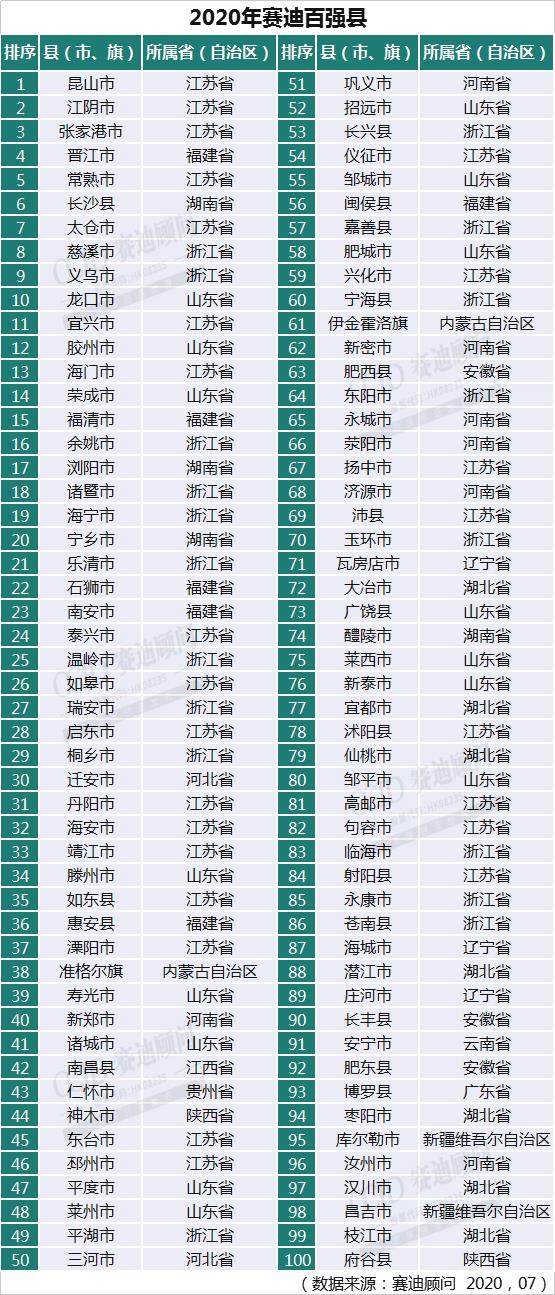
County is an important space for China to promote industrialization and urbanization, and county economy also plays an important role in the national economy. The Paper (www.thepaper.cn) reporter combed and found that among the top 100 counties in recent years, the seats in the central and western regions increased significantly.
In this year’s list of the top 100 counties, the eastern region accounts for 68 seats, the central region accounts for 21 seats, the western region accounts for 8 seats, and the northeast region accounts for 3 seats. Compared with 2019, the number of seats in the eastern region decreased by 3 seats, the central region increased by 2 seats, the western region increased by 1 seat, and the northeast region remained unchanged. This means that from the perspective of county economy, the strategy of the rise of China’s central and western regions has achieved initial results.
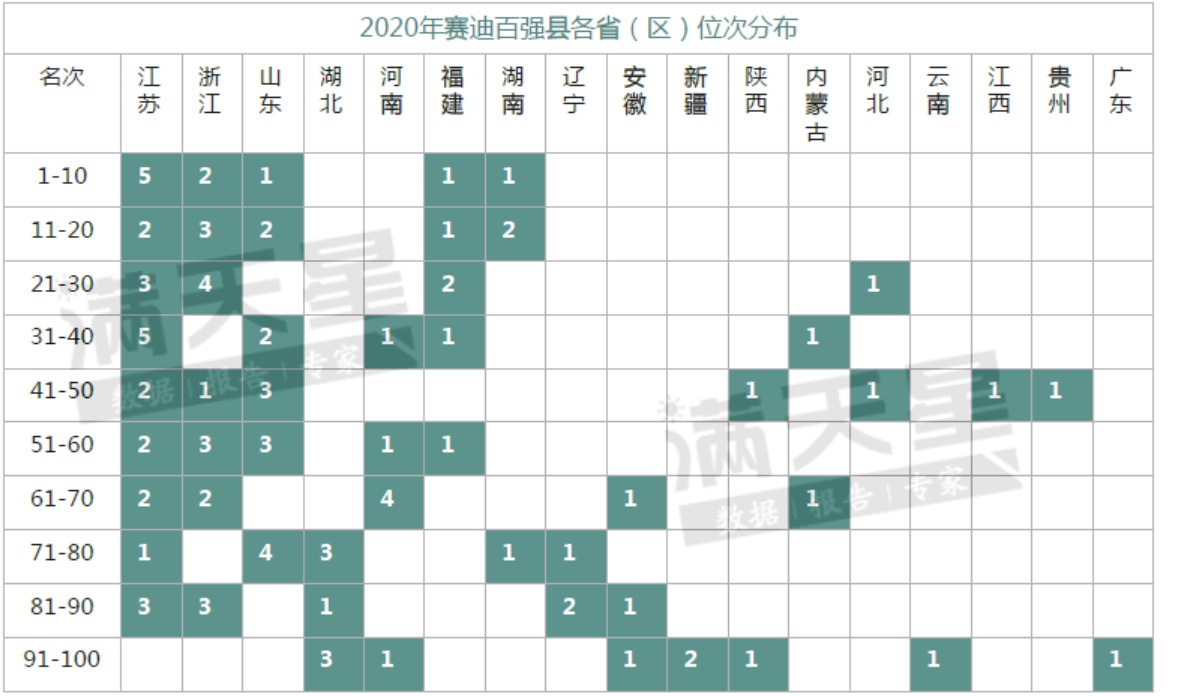
Rank distribution of provinces (regions) in the top 100 counties of CCID in 2020
"Strong province and strong county, leading Jiangsu" is the outstanding feature of this year’s list of top 100 counties. Among the top 10 of the top 100 counties, Jiangsu Province occupies half of the total and takes the top 3. Jiangsu, Zhejiang and Shandong provinces performed well, accounting for 25 seats, 18 seats and 15 seats respectively.
Ma Chengen, director of CCID Consulting County Economic Research Center, said that the overall strength of the top 100 counties is outstanding. Among the top 100 counties, the number of counties with GDP exceeding 100 billion reached 33, an increase of 3 over the previous year. The GDP of Kunshan City and Jiangyin City in Jiangsu Province has exceeded 400 billion yuan, which is equivalent to that of provincial capitals such as Taiyuan City and Guiyang City. The top 100 counties account for less than 2% of the country’s land and 7% of the population, creating one-tenth of the country’s GDP;; With less than 3% of the county’s land and 11% of the population, it has created about a quarter of the county’s GDP.
Consumption is strong, and the per capita GDP reaches the level of high-income countries.
Research shows that in 2019, the per capita GDP of the top 100 counties reached 110,900 yuan, far exceeding the national average, second only to Jiangsu Province. According to the World Bank’s classification criteria for low, middle and high-income countries, the per capita GDP of the top 100 counties has reached the level of high-income countries.
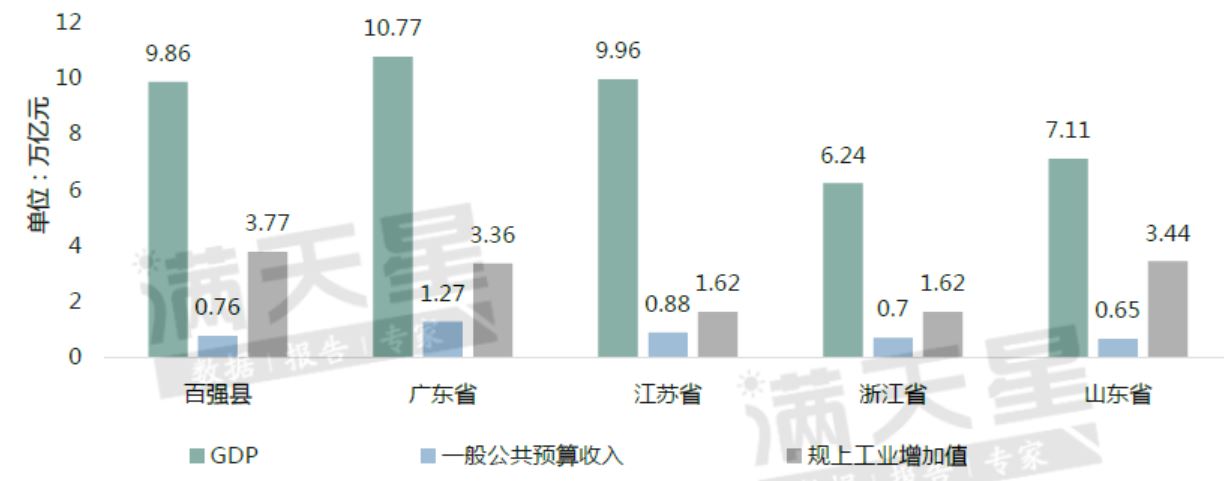
Comparison of economic scale between the top 100 counties and the four provinces of Guangdong, Jiangsu, Zhejiang and Shandong in 2019
Compared with some major economic provinces, in 2019, the GDP and general public budget revenue of the top 100 counties were slightly lower than those of Guangdong and Jiangsu provinces, and higher than those of Zhejiang and Shandong provinces. The dimension of industrial added value above designated size exceeds the four provinces of "Guangdong, Jiangsu, Zhejiang and Shandong", which shows the strong industrial strength of the top 100 counties.
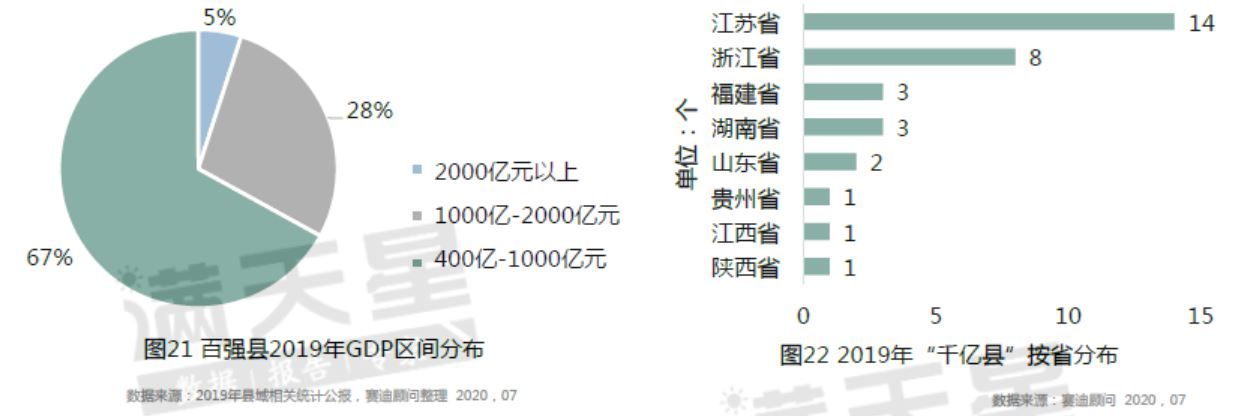
Ma Chengen said that the income and consumption power of residents in the top 100 counties are much higher than the national average. In 2019, the per capita disposable income of top 100 counties was 38,700 yuan, the per capita disposable income of urban residents reached 48,000 yuan, and the per capita disposable income of rural residents reached 25,400 yuan, which was 26%, 13% and 59% higher than the national level in that year.
In terms of consumption, the per capita retail sales of consumer goods in Baiqiang County in 2019 was 36,900 yuan, which was 25.5% higher than the national average of 29,400 yuan. The research shows that the county provides a space to undertake the transfer of industrial resources. At the same time, the county has a large population base, and the consumption needs to be further developed, with huge consumption potential.
At the same time, the top 100 counties have significantly improved their ability to attract funds and population. In 2019, the balance of local and foreign currency deposits of financial institutions in Baiqiang County was 10.92 trillion yuan, equivalent to that of Shandong Province. The research shows that the higher the population density of the counties ranked in the top 100 counties, the stronger the ability to gather population.
Overall, it is in the late stage of industrialization, and it has initially got rid of investment dependence.
From the perspective of industrial structure, industry is a strong engine for the development of the top 100 counties, the pulling effect of fixed assets investment on development is declining, and economic kinetic energy is in the process of transformation.
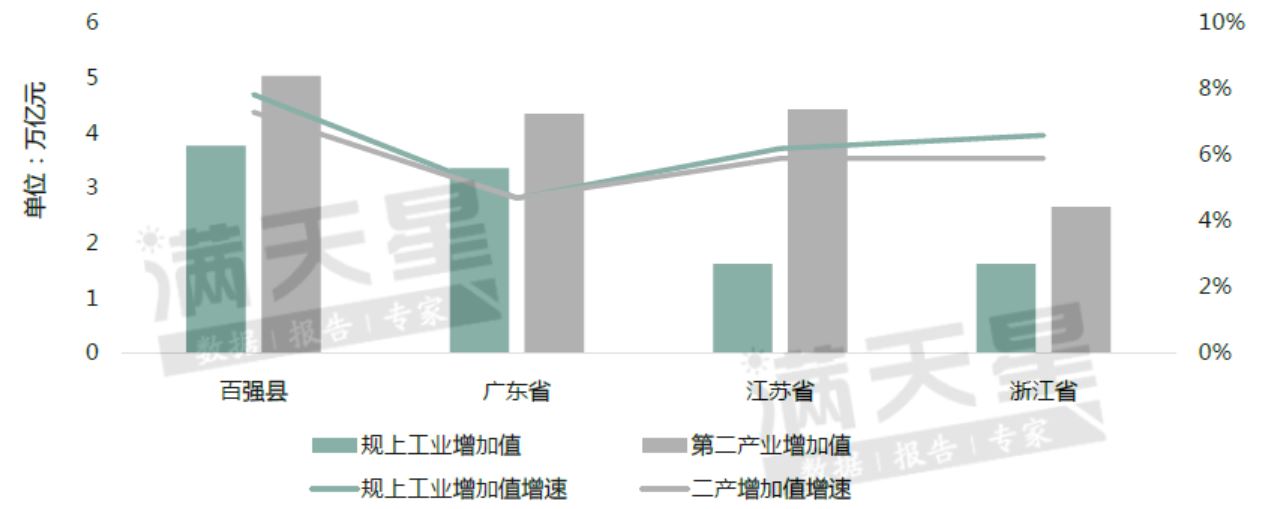
Comparison of industrial values between the top 100 counties and the four provinces of Guangdong, Jiangsu, Zhejiang and Shandong in 2019
In 2019, the added value of industrial enterprises above designated size and the added value and growth rate of the secondary industry in the top 100 counties far exceeded those in developed provinces such as Jiangsu, Zhejiang and Guangdong. It can be seen that the secondary industry is the main driving force for the development of the top 100 counties.
CCID said that according to the stages of Chenery’s industrialization process, the top 100 counties are in the late stage of industrialization. From the level of industrial structure, the tertiary industrial structure of the top 100 counties is that the added value of the primary industry is less than 10%, and the proportion of the secondary industry is greater than that of the tertiary industry, which is also in the late stage of industrialization.
CCID Consultant suggested that in the next development of the top 100 counties, we should improve the quality of the overall supply system of the secondary industry and improve the adaptability of the supply structure to the demand structure. "The most important thing is to reduce the ineffective supply of the secondary industry and expand the effective supply."
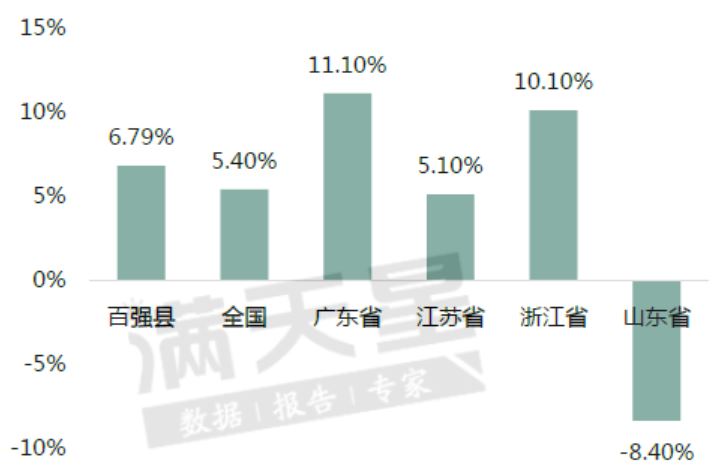
Comparison of the growth rate of total fixed investment between the top 100 counties and the whole country and some provinces in 2019
In 2019, the average growth rate of total fixed assets investment in the top 100 counties was 6.79%, still higher than the national level of 5.4%. Among them, the fixed assets investment in four counties accounts for more than 100% of GDP, and 42 counties are between 50% and 100%.
It is worth noting that in the latest list of the top 100 counties, the counties with fixed assets investment accounting for less than 50% of GDP exceeded half for the first time. At the same time, the total fixed assets investment of the top 100 counties in 2019 was 4.59 trillion yuan, accounting for 45.6% of the regional GDP, which was lower than the national average (56.6%).
CCID explained that this shows that the role of fixed assets investment in the top 100 counties is declining, indicating that the top 100 counties have initially bid farewell to investment dependence and turned to an economic structure that pays equal attention to investment, consumption and export, and the economic kinetic energy is in the process of transformation.
However, it can not be ignored that fixed assets investment is still an important force to stimulate economic growth for the whole county. In addition, the role of export in promoting the economic development of the top 100 counties is limited at present. In 2019, the total import and export volume of the top 100 counties was 3.51 trillion yuan, which is still far from Guangdong Province with the same economic volume.
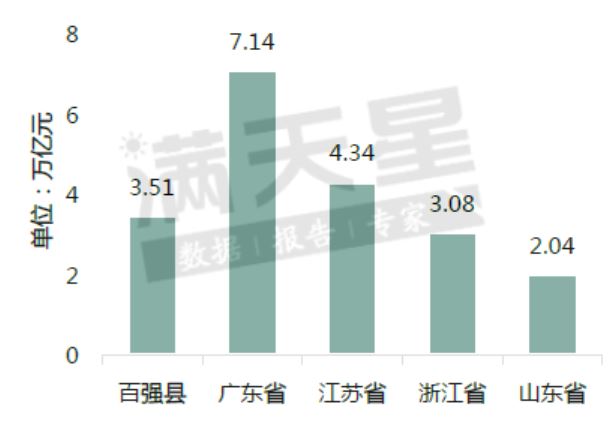
Comparison chart of total import and export volume between top 100 counties and some provinces in 2019
At the same time, it is worth noting that there are great differences within the top 100 counties in terms of import and export. Take the proportion of total import and export to GDP as an example. Yiwu, the highest city, has reached more than 200%, showing the development achievements of opening to the outside world, while 70% of counties are below the national average (31.8%), and the proportion of some top 100 counties is even less than 1%.
The tertiary industry has strong development potential, and scientific and technological innovation is the support for development.
The research shows that the tertiary industry accounts for only 43.4% of the three industrial structures in the top 100 counties, which is far below the national level and the level of economically developed provinces such as "Guangdong, Jiangsu, Zhejiang and Shandong" in the same period. At the same time, the growth rate of the tertiary industry is slower than that of the secondary industry.
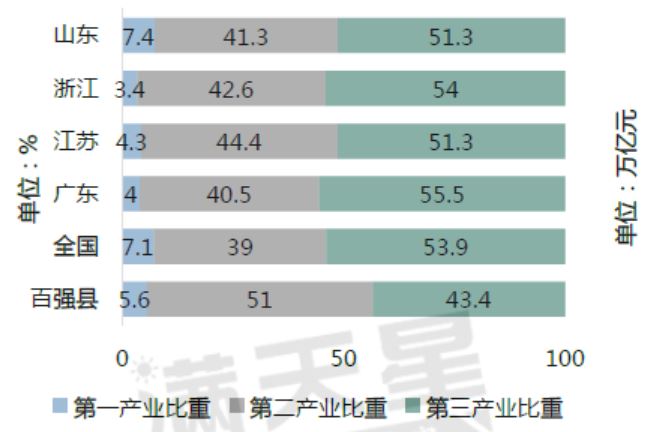
Comparison chart of three industrial structures between the top 100 counties and the whole country and some provinces in 2019
Therefore, CCID believes that the development of the tertiary industry can effectively improve the urbanization level, industrial added value and scientific and technological innovation vitality of the top 100 counties, and the development of the tertiary industry will become the focus that cannot be ignored in the economic development of the top 100 counties in the future.
The research points out that the county should focus on promoting scientific and technological innovation and shaping new advantages with new technologies, new products and new services as the core; Counties should accelerate new urbanization, promote urban-rural coordination, and actively integrate into the new regional pattern with urban agglomerations as the main body.
In June this year, the National Development and Reform Commission also issued a notice, pointing out that it is necessary to promote the upgrading of municipal public facilities in county towns and accelerate the work of urbanization in county towns to make up for shortcomings.
CCID believes that in this respect, it is necessary to promote the construction of public service facilities in the county, promote the balanced allocation of public resources in urban and rural areas, and at the same time, focus on improving the level of modern service industry, tap the advantages of characteristic resources, culture and location, and actively expand the production and service capacity while meeting the production and living needs of county residents.
CCID Consulting also released a report earlier, pointing out that, first, the manufacturing mode has changed to intelligent and green, and service-oriented manufacturing has become an important direction for manufacturing upgrading; Second, emerging economic forms such as digital economy, platform economy, sharing economy and creative economy are constantly emerging; Third, new technologies are changing the value chain of global industries and changing the layout of international productive forces.
Under this background, the next development of county economy should seize the opportunity of scientific and technological revolution and industrial transformation, promote the industry to leap to the middle and high end, and at the same time, rely on the advantages of county resources and the foundation of industrial development to accelerate the formation of new advantages of county economy.
(This article is from The Paper, please download the "The Paper" APP for more original information)